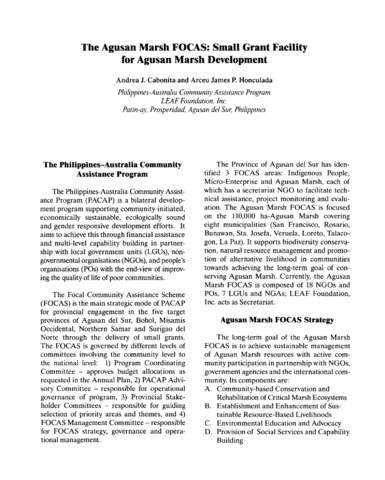Distribution of the avifauna of Agusan marsh, Agusan del Sur, Philippines
| dc.contributor.author | Sucaldito, Milagros P. | |
| dc.contributor.author | Nuñeza, Olga M. | |
| dc.date.accessioned | 2022-03-14T08:38:05Z | |
| dc.date.available | 2022-03-14T08:38:05Z | |
| dc.date.issued | 2008 | |
| dc.identifier.citation | Sucaldito, M. P., & Nuñeza, O. M. (2008). Distribution of the avifauna of Agusan marsh, Agusan del Sur, Philippines. In J. H. Primavera (Ed.), Proceedings of the 1st Scientific Conference on the Agusan Marsh: Butuan City, Agusan del Norte, Philippines, 21-23 May 2007 (pp. 51-68). UNESCO Jakarta Office, Philippine Council for Aquatic and Marine Research and Development. | en |
| dc.identifier.uri | http://hdl.handle.net/10862/6302 | |
| dc.description.abstract | The Agusan Marsh is the 1009th RAMSAR site, a wildlife sanctuary which serves as wintering ground for migratory and wetland birds from Asian and Western countries, and is considered one of the most ecologically significant wetland ecosystems in the Philippines. This study assessed species diversity and distribution of birds in four habitat types of the Agusan Marsh. Sago, Terminalia, Mixed Swamp and Peat Swamp forests in the Marsh were surveyed from August 2005 to January 2006 using a combination of mist netting (3,337 net days) and transect walk methods. One hundred twenty-six species of birds were identified consisting of 26 migrants, 69 non-endemics, and 31 endemics (23.81% endemism) of which seven species are categorized as threatened. The Mixed Swamp Forest had the highest species richness (S=92) while the Peat Swamp Forest had the highest number of migratory birds (S=26). Highest endemicity was recorded in the Terminalia Forest (20.63%) while the Sago Forest had the least number of bird species. Migratory birds were recorded at the start of sampling in August, their numbers considerably increasing thereafter and reaching a peak in November. In contrast, the number of endemic species declined in the same month. Previously recorded only in Luzon, the migratory Siberian Rubythroat (Luscinea calliope) was also found in Agusan Marsh, indicating that this bird may be found in other places in the Philippines. Forty-six species of birds, which include six migratory species, were reported to be of socioeconomic importance. Changes in structural and floristic composition brought about by forest degradation, such as conversion of forest into agriculture, logging and hunting, were seen as threats to the birds in Agusan Marsh. Results indicate that the Marsh supports a considerable number of endemic, threatened, and migratory bird species. Conservation of the different Marsh habitats is necessary for the protection of the broadest avifaunal diversity. | en |
| dc.language.iso | en | en |
| dc.subject | Agusan Marsh | en |
| dc.subject | birds | en |
| dc.subject | avifauna | en |
| dc.title | Distribution of the avifauna of Agusan marsh, Agusan del Sur, Philippines | en |
| dc.type | Conference paper | en |
| dc.citation.spage | 51 | en |
| dc.citation.epage | 68 | en |
| dc.citation.conferenceTitle | Proceedings of the 1st Scientific Conference on the Agusan Marsh: Butuan City, Agusan del Norte, Philippines, 21-23 May 2007 | en |
| dc.subject.asfa | marshes | en |
| dc.subject.asfa | waterfowl | en |
| dc.subject.scientificName | Luscinia calliope | en |
Files in this item
| Files | ขนาด | รูป | View |
|---|---|---|---|
|
There are no files associated with this item. |
|||




